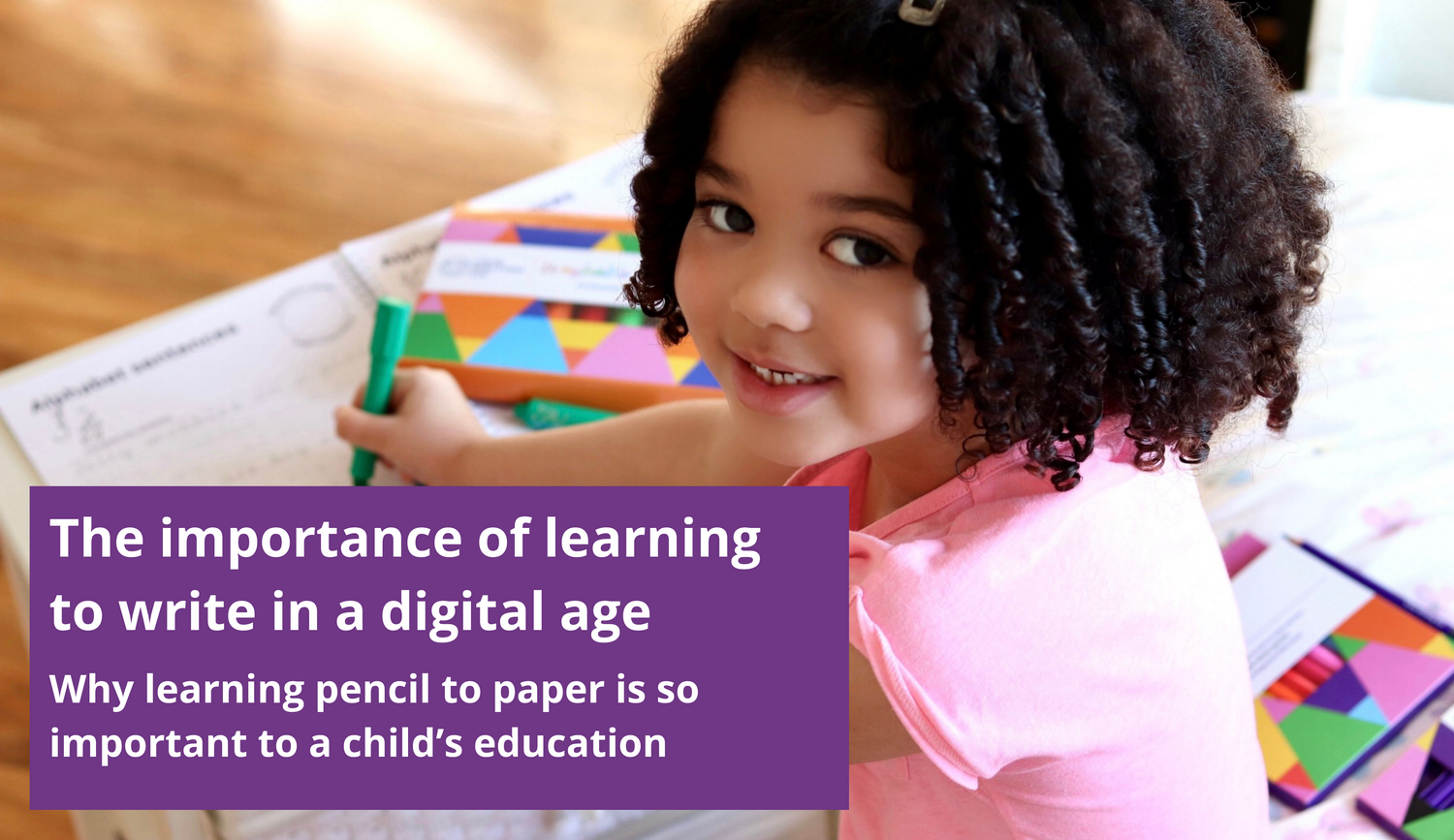Why is it so important to help my child learn to write?
In the age of technology, the lifelong skill of learning to write remains important in not only a child's education but everyday life.
Check out our Top 9 reasons of 'The Importance of learning to write' and why we believe learning to write pencil to paper is still massively crucial in this day and age.
-
Improved reading skills

Often, the first words children read are the first words that they write.
Handwriting practice provides children with early years confidence with their literacy skills. Building a solid writing foundation will contribute towards your child’s reading fluency.
When your child puts pencil to paper, it activates the visual perception of letters. If they can identify letters, it means that they can begin to practice writing them. If your child can write, they can read - it’s that simple!
Our handwriting practice workbooks are designed to encourage children not only to write the letters of the alphabet, but also identify them in an upper and lower case form. Click here to see why 10,00’s+ of parents choose to use our handwriting practice workbooks to improve their child’s literacy skills today.
-
Improved motor skills

Learning to write is phenomenal for developing and improving fine and gross motor skills in children. What many people do not know is that the action of writing helps to improve children’s posture, motor dexterity and hand-eye coordination.
As your child begins to mark-make and form letters, it engages their fine motor muscles within their hands, wrists and fingers whilst grasping a pencil. Not only are the hands engaged when writing, but also their arms and their whole body! Good handwriting requires good posture too, this means their core has to be engaged, sitting up straight in order to prevent muscle fatigue and support their arm-hand mobility.
Check out our Instagram and facebook page here and follow us for hints and tips on posture for sitting down and writing, paper position for left and right handers and all things writing tips.
-
Improved emotional intelligence

Idea: a reading and writing corner - we love this ideas of setting up a quiet corner in a room in your house that your child can go to to read and write. Having a designated area allows your child to associate the area with ‘calm time’ and take a moment to unwind whilst their mind can become activated and creative when writing, colouring or drawing.
A great way to promote emotional ability is to ask your child to write down how they feel, if they feel they cannot say something out loud (which is very common for many children) writing their feelings down is a great tool for mindfulness. It helps to structure your thoughts and can be an excellent way of improving communication skills and emotional intelligence.
Top Tip to improve handwriting and pencil grip and control: Use Love Writing Co. small chunky handwriting pencils, perfect for school and home learning for ages 3-9. Click here to shop.
-
Improved cognitive ability

Writing by hand has lots of cognitive benefits, especially for children.
Because writing by hand takes longer, you have time to think strategically about what you are noting down. This enables the writer to slow down and think about the words, spelling and structure of the writing. This thought process, and the physical act of writing something down improves cognitive ability, concentration and even memory.
Top Tip to improve handwriting and pencil grip and control: Use Love Writing Co. 3-in-1 Washable Arty Crayons: Crayon, Pastel and Watercolour chunky sticks - Pack of 12 vivid colours for cognitive development. The bright, colourful sticks are perfect for enhancing cognitive colour recognition. Click here to shop 10% off.
-
Enhanced creativity & imagination through handwriting

Holding a pencil to paper unquestionably unlocks creativity that technology simply does not allow for. Pencil to paper allows children to be imaginative, artistic and free with their thoughts.
Mark-making is the first step to building a solid writing foundation. Often what looks like scribbles to an adult eye, tell a whole story to a child. When you find your child being creative and artistic with their writing or drawing, ask them why they did it and what it means - this will allow them to be creative in their speech and help you understand their thought process.
A Little more about the crayons for you here:
- Three creative uses, crayons, pastels and watercolours.
- 12 vivid and rich colours
- No mess, no waste, no odour
- Washable and non-toxic
- Plastic outer case - keeps little hands clean
- Smooth and easy glide - preventing heightened pressure
- Twist and retract style - to improve fine motor skills
I mean, is there anything they can’t do?! See the magic for yourselves…
-
Learning a new skill
A top tip when teaching our children new skills (which can sometimes be frustrating for them) is that any skill worth having and important to us in life does indeed require patience, perseverance, and diligence - Learning to write requires all of these things for sure!
Learning new skills builds independence, confidence and self-esteem. Encouraging children to learn new skills gives kids a sense of accomplishment and pride which sets them up for a future full of achievement and success.
If you are looking for ways to incorporate positive thinking about new skills and everyday life, check out our Positive Affirmation Bookmarks - Traceable, Colouring bookmarks pack of 4
Click here to shop. Perfect for encouraging self-love, belief and confidence when reading.

-
Teaches the notion that handwritten is heartfelt

Handwritten notes to friends and loved ones are intimate and personal, but cards, letters and drawings made by little ones are truly special gifts to cherish forever!
Imagine looking back in ten years time to see how their handwriting was and the funny things they came up with in their childhood.
‘’I love you more than sweeties’’ (smiling ear to ear already)
-
Life-long skill for education and careers

It is a key aim and skill for children to be able to write, identify and read their own name. It's undeniably a life-long required skill.
Handwriting is needed throughout your child's academic life and also through work life as they get older. Most exams in today's day and age require written test papers and we all remember how daunting they can be - so helping to get our children happy and confident in writing certainly will help this process.
You just can't beat a handwritten date on the top of your notes can you!
-
Handwriting is History and should be a part of our future
Take a look back through history, think about the importance of certain historical documents that make up history as we know it today. All of these documents are written in such a way that without being able to read handwriting (often cursive), it would be very difficult to make out what these documents say.
Most historical documents you will find have been written in cursive which is now taught to our children at around 6 years old. The ability to read handwriting is gained through learning to write in one's own handwriting. Being able to decipher both non-cursive and cursive handwriting is an important part of language literacy.
How we can help your child learning to write…
Whether they are picking up a pencil for the first time, writing their name or improving their skillset, we have the resources for you.
Our specially designed resources help children to write easier and quicker. SHOP THE COLLECTION HERE
- Small chunky writing pencils for kids that improve grip and control, reduce hand fatigue and strain and improve handwriting formation
- Fun handwriting activity practice books that support the national curriculum, we are ready to help your child build a solid writing foundation.
- Free resource worksheets today - simply sign up to our newsletter and they will come straight to your inbox!
- Pencil-case perfect stationery
- Lots more for ages 3-9 years
- SEND friendly





1 comment
Mrs S
Great article. Handwriting has always been and will always be one of the most important thing a child can learn. Your resources are brilliant, my kids really enjoy using them. thanks.
Leave a comment
All comments are moderated before being published.
This site is protected by hCaptcha and the hCaptcha Privacy Policy and Terms of Service apply.